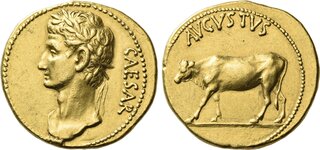Lot description:
Octavian as Augustus, 27 BC – 14 AD.
Aureus, uncertain mint after 27 BC, AV 20 mm, 7.90 g. CAESAR Laureate bust l. Rev. AVGVSTVS Heifer walking l. C 27. Bahrfeldt 139. BMC –, cf. 661 (heifer r.). RIC 536 (misdescribed). CBN 1007 (these dies). Biaggi 86 (this coin). H. Rambach - A. Walker, The 'Heifer' Aurei of Augustus in SNR 91, 3.3 (this coin). Calicó 170 (this coin).
Of the highest rarity, only three specimens known, of which this is the only one in private
hands (the other specimens are at the BN in Paris and at the Hermitage Museum in
St. Petersburg). A portrait of enchanting beauty inspired by Hellenistic art, work
of a very talented master engraver. Undoubtedly one of the finest if not best
of the entire series. Extremely fine
Ex Santamaria 1949, Magnaguti part II, 375; NAC 15, 1999, 240 and NAC 45, 2008, Barry Feirstein, 61 sales. From the Biaggi collection.
The 'heifer' aurei stand out among all of Augustus' coins as articles of the highest workmanship. On this particular coin the open space in the fields combines with the long, sharply modelled neck to achieve the rare effect that one is gazing upon a sculpted marble bust from the optimal angle. In point of fact this is not far from the truth, as it is almost certainly how the engraver was able to produce a die of this calibre. At least six obverse dies and six reverse dies were used to strike the 'heifer' aurei. It is clear that one engraver was responsible for the three portrait dies on which Augustus' head is broad and voluminous (Bahrfeldt 1 and 2; Calicó 169), and that another artist produced the three obverse dies that have narrow busts with sharply defined features (Bahrfeldt 3 and 4; Calicó 172). The stylistic range of all six dies is represented by the present coin and two 'heifer' aurei offered in earlier NAC auctions (sale 38, lot 2; sale 41, lot 37). It seems likely that more than one artist was responsible for the reverse dies, but this is not easy to determine. The reverse, both in terms of style and subject matter, is of equal interest to the obverse, for on the various dies we can observe different postures and viewing angles for the heifer. Most often it is shown walking slowly to the left with its head slightly lowered, but on at least two dies the heifer faces right – in one case at a full stop with its head raised. The heifer is generally believed to represent a group of bronze statues cast in the fifth century B.C. by the sculptor Myron which were requisitioned from Athens and shipped to Rome by Octavian after his victory at Actium. Myron's cows were monumental prizes of great antiquity, but the Greeks could do little to object to the confiscation since the victor Octavian wanted them to adorn an altar in his Temple of Apollo on the Palatine, dedicated in 28 B.C. Sextus Propertius notes that Augustus used the statues to decorate an altar within the temple: "...round the altar, stood four of Myron's cattle, carved statues of oxen, true to life." (The Love Elegies, Book II:31). A cow that must also represent these sculptures appears on coins of Vespasian struck in 74 and 76, and since that emperor used Myron's cows to decorate his new Temple of Pax, completed in 74, we find a good explanation for the recycling of this attractive Augustan type. Indeed, we find corroboration in the mid-6th Century De bello Gothico, a work of the historian Procopius, that Myron's famous cows were then still in the Forum of Peace in Rome. The mint for these coins has yet to be determined, but the consensus of published opinions points to a mint in the East. For comparison we note a related issue of aurei and denarii, perhaps struck at Pergamum (see Calicó 172a), that is identical except that a bull is shown in place of the heifer, and the style and fabric are of an entirely different character.
Estimate: 350000 CHF |  |